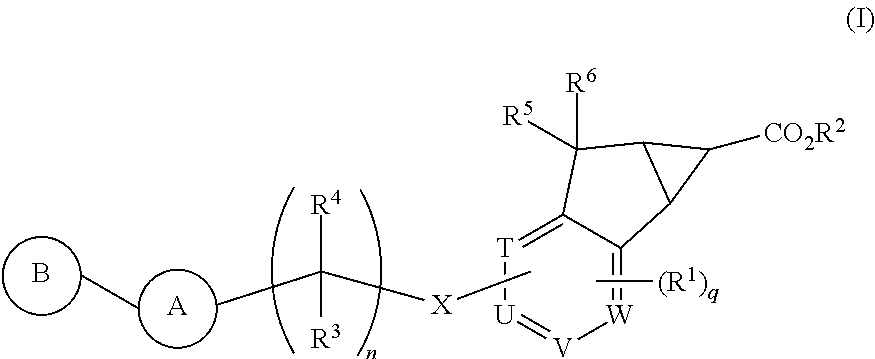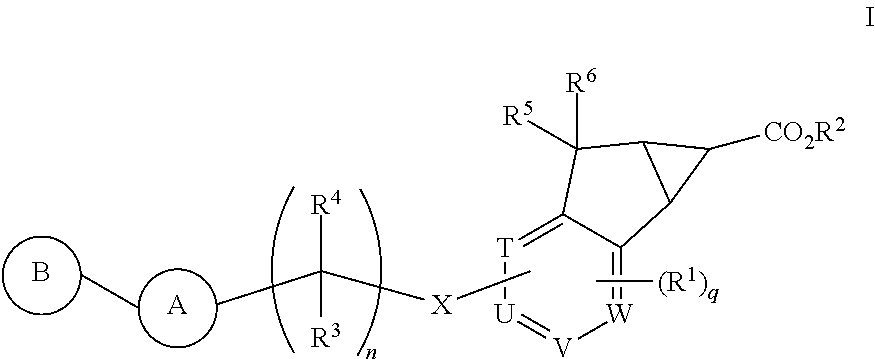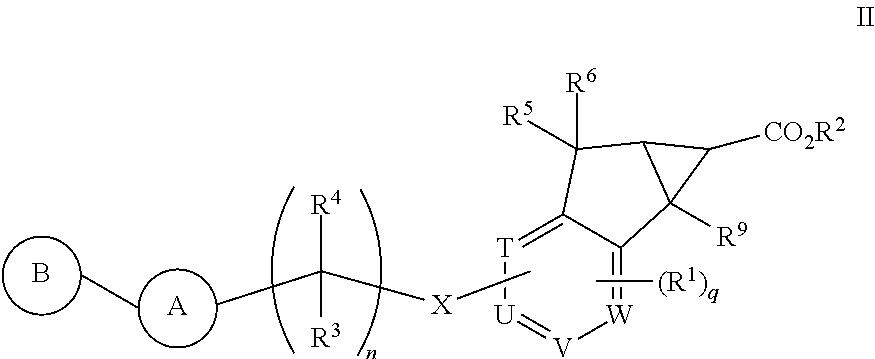Antidiabetic tricyclic compounds
a tricyclic compound and antidiabetic technology, applied in heterocyclic compound active ingredients, drug compositions, metabolic disorders, etc., can solve the problems of increased and premature morbidity and mortality, inadequate insulin-mediated repression of lipolysis in adipose tissue, and insufficient insulin-mediated activation of uptake, oxidation and storage of glucose in muscle,
- Summary
- Abstract
- Description
- Claims
- Application Information
AI Technical Summary
Benefits of technology
Problems solved by technology
Method used
Image
Examples
example 1
(5aR,6S,6aS)-3-((3′-(2-(trifluoromethyl)phenyl)-2′,3′-dihydrospiro[cyclopropane-1,1′-inden]-5′-yl)methoxy)-5,5a,6,6a-tetrahydrocyclopropa[4,5]cyclopenta[1,2-c]pyridine-6-carboxylic acid (compound A1-8)
[0897]
Step A: methyl 1-oxo-3-(2-(trifluoromethyl)phenyl)-1H-indene-5-carboxylate (A1-1)
[0898]To a mixture of compound 3-5 (1.0 g, 3.14 mmol) in 1,4-dioxane (15 mL) was added SeO2 (1.047 g, 9.4 mmol), and the resulting mixture was heated to reflux for 72 hours. After cooling to room temperature, MeOH was added to quench the reaction. The mixture was stirred for 30 min., and then filtered through Celite®. The filtrate was concentrated in vacuo to afford to a residue, which was purified by chromatography over silica gel to afford compound A1-1. MS (ESI) m / e (M+H+): 333.1
Step B: methyl 1-oxo-3-(2-(trifluoromethyl)phenyl)-2,3-dihydro-1H-indene-5-carboxylate (A1-2)
[0899]Rh(PPh)3Cl (118 mg, 1.27 mmol) was added to a solution of compound A1-1 (848 mg, 2.55 mmol) in a co-solvent of t-BuOH (10 m...
example 3
(5aR,6S,6aS)-3-((1,1-dimethyl-3-(2-(trifluoromethyl)phenyl)-2,3-dihydro-1H-inden-5-yl)methoxy)-5,5a,6,6a-tetrahydrocyclopropa[4,5]cyclopenta[1,2-c]pyridine-6-carboxylic acid (Compound A2-6)
[0906]
Step A: methyl 1,1-dimethyl-3-(2-(trifluoromethyl)phenyl)-1H-indene-5-carboxylate (A2-1)
[0907]To a stirred solution of compound 3-5 (0.1 g, 0.31 mmol) in THF (2 ml) and HMPA (0.4 ml) at −78° C. under a nitrogen atmosphere was added KHMDS (1.0 M in THF, 0.93 mL, 0.93 mmol) dropwise. After completion of the addition, the mixture was stirred for 2 hours, then a solution of MeI (107 mg, 0.75 mmol) in THF (0.2 mL) was added dropwise. The resulting mixture was stirred at −78° C. for 1 hr, then warmed to 0° C. slowly and stirred for another 30 min. The reaction was quenched with saturated aqueous NH4Cl. Then the mixture was extracted with EtOAc three times. The combined organic layers were washed with brine, dried over Na2SO4 and concentrated in vacuo to afford a residue, which was purified by prep...
example 4
(5aR,6S 6aS)-3-(1,1-dimethyl-3-(2-(trifluoromethyl)phenyl)-2,3-dihydro-1H-inden-5-yl)methoxy)-5,5a,6,6a-tetrahydrocyclopropa[4,5]cyclopenta[1,2-c]pyridine-6-carboxylic acid (Compound A3-5)
[0913]
Step A: (1,1-dimethyl-3-(2-(trifluoromethyl)phenyl)-1H-inden-5-yl)methanol (A3-2)
[0914]To a suspension of LiAlH4 (53 mg, 1.4 mmol) in dry THF (4 mL) at 0° C. was added a solution of compound A2-1 (100 mg, 0.3 mmol) in THF (2 mL) dropwise. After completion of the addition, the reaction mixture was stirred at this temperature for 1 h. Saturated aqueous NH4Cl was then added to quench the reaction and the mixture was extracted with EtOAc twice. The combined organic layers were washed with brine, dried over Na2SO4 and concentrated in vacuo to afford compound A3-2, which was used in the next step without purification.
Step B: 5-(bromomethyl)-1,1-dimethyl-3-(2-(trifluoromethyl)phenyl)-2,3-dihydro-1H-indene (A3-3)
[0915]To a solution of crude compound A3-2 (90 mg, 0.3 mmol) in dry THF (5 mL) at 0° C. w...
PUM
| Property | Measurement | Unit |
|---|---|---|
| enantiomeric excess | aaaaa | aaaaa |
| enantiomeric excess | aaaaa | aaaaa |
| enantiomeric excess | aaaaa | aaaaa |
Abstract
Description
Claims
Application Information
 Login to View More
Login to View More - R&D
- Intellectual Property
- Life Sciences
- Materials
- Tech Scout
- Unparalleled Data Quality
- Higher Quality Content
- 60% Fewer Hallucinations
Browse by: Latest US Patents, China's latest patents, Technical Efficacy Thesaurus, Application Domain, Technology Topic, Popular Technical Reports.
© 2025 PatSnap. All rights reserved.Legal|Privacy policy|Modern Slavery Act Transparency Statement|Sitemap|About US| Contact US: help@patsnap.com



